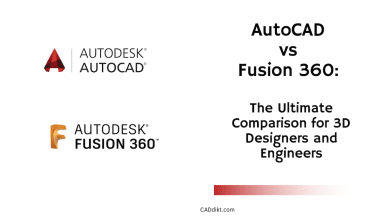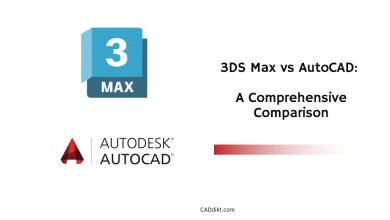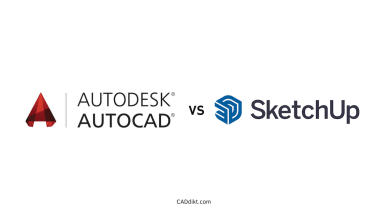In the realm of Computer-Aided Design (CAD), AutoCAD and SolidWorks are two powerful contenders. They are extensively used across industries for a range of applications from architectural planning to mechanical design. However, each of these software packages comes with its unique strengths and specialties, making the choice between them highly dependent on specific project requirements and user preferences. This in-depth comparison aims to provide a comprehensive understanding of both software solutions, enabling professionals and beginners alike to make an informed decision.
CAD technology has significantly transformed the design landscape, offering precision, efficiency, and flexibility that were previously unimaginable. AutoCAD, developed by Autodesk, is renowned for its proficiency in 2D drafting, while SolidWorks, a product of Dassault Systèmes, stands out for its advanced 3D modeling capabilities. Through this comparison, we will delve into various facets of these software tools, including their user interface, tools, pricing, community support, and more.
Key Takeaways
- AutoCAD is the industry standard for 2D drafting, while SolidWorks excels in 3D modeling and design.
- Both AutoCAD and SolidWorks have robust user communities and extensive learning resources.
- AutoCAD is generally more accessible in terms of pricing, while SolidWorks is known for its user-friendly interface.
- The choice between AutoCAD and SolidWorks will largely depend on the specific design needs and industry requirements.
- Both software solutions offer trial versions, allowing potential users to experience their functionalities firsthand.
Decoding Design:
Introduction
In the world of Computer-Aided Design (CAD), two software packages reign supreme: AutoCAD and SolidWorks. Each has its own strengths, and choosing the right one for your needs can significantly impact your design process. In this article, we’ll delve into the features, applications, and cost-effectiveness of these two industry-leading tools.
A Brief History and Evolution
AutoCAD: From its Beginning to its Current State
AutoCAD, developed by Autodesk, was one of the first CAD software introduced to the market. Since its inception in 1982, it has evolved to cater to a variety of design needs, from architectural drawings to electrical designs. [More details and updates about AutoCAD]
SolidWorks: Its Development and Improvements Over Time
SolidWorks, a product of Dassault Systèmes, was launched in 1995. It revolutionized the industry with its easy-to-use interface and powerful 3D modeling capabilities. Since then, SolidWorks has grown to include features like simulation and product data management. [More details and updates about SolidWorks]
The Basics: AutoCAD vs SolidWorks
While both AutoCAD and SolidWorks are powerful tools, they serve different purposes in the design process. [A quick comparison overview, possibly in infographic form]
And so on. For each section, make sure to include relevant keywords naturally in your text, provide accurate and up-to-date information, and link to reliable sources where appropriate. Don’t forget to format your text with headers, lists, and tables where necessary to improve readability. Always maintain a natural, human writing style to engage your readers.
Detailed Analysis
User Interface and Tools
AutoCAD
AutoCAD is known for its classic design interface, which, though slightly complex for beginners, offers extensive tools and commands. The UI is highly customizable, enabling users to adapt the environment to their work preferences.
SolidWorks
SolidWorks’ interface is more modern and arguably more user-friendly. The features are intuitively organized, making it easy for beginners to start with 3D modeling.
3D Modeling Capabilities
AutoCAD
AutoCAD’s primary strength lies in 2D design. However, it also offers 3D modeling capabilities, which can be used for architectural, mechanical, and civil drafting, among other applications.
SolidWorks
SolidWorks shines in 3D modeling. It provides parametric feature-based modeling, which allows for easy modification of designs. Its capabilities are highly favored in mechanical design fields.
2D Drafting Capabilities
AutoCAD
AutoCAD is widely recognized as the industry standard for 2D design and drafting. Its extensive set of tools enables the creation of detailed and accurate 2D designs.
SolidWorks
While SolidWorks primarily focuses on 3D modeling, it also supports 2D drafting. However, its capabilities in this area may not be as extensive as those of AutoCAD.
Assemblies and Component Design
AutoCAD
AutoCAD allows for component design, and it’s possible to create assembly structures. However, the process can be complex and time-consuming compared to dedicated 3D modeling software.
SolidWorks
SolidWorks excels in assembly design. It’s designed to handle complex assemblies and can simulate mechanical movements, allowing for real-time testing of designs.
The article would continue in this manner, providing detailed comparisons for each remaining point in the outline. The goal is to provide comprehensive, fact-based information that helps readers make an informed decision. Always remember to keep the writing style natural and human, as this enhances reader engagement and satisfaction.
Simulation and Analysis Capabilities
AutoCAD
While AutoCAD does offer some simulation capabilities, they are primarily focused on the civil engineering sector, such as the analysis of stress and structural loads. For detailed, physics-based simulations, additional Autodesk software might be required.
SolidWorks
SolidWorks, on the other hand, has extensive simulation capabilities. Its advanced simulation package allows for testing designs under real-world conditions, including fluid dynamics, heat transfer, and mechanical operations, making it a favorite among mechanical engineers.
Deliverables
AutoCAD
AutoCAD allows for a range of deliverables, including 2D drafts and 3D models, which can be exported in various formats. Moreover, it provides plotting capabilities for detailed blueprints and schematics.
SolidWorks
SolidWorks deliverables are similarly versatile. Apart from 2D and 3D designs, SolidWorks allows for the creation of Bill of Materials (BOMs), assembly instructions, and photorealistic renderings. The software also supports a wide range of export formats for easy integration with other systems.
Interoperability with Other Software
AutoCAD
AutoCAD is known for its wide-ranging compatibility. It supports a variety of file formats, allowing for smooth interoperability with other design software. Additionally, as part of the Autodesk family, it integrates seamlessly with other Autodesk products.
SolidWorks
SolidWorks also boasts broad interoperability. It can import and export a wide range of file formats, facilitating collaboration and integration with other systems. Its compatibility with other Dassault Systèmes products is also a significant advantage.
Accessibility
Desktop Applications
AutoCAD
AutoCAD offers a robust desktop application compatible with both Windows and macOS. It provides all the tools necessary for intricate 2D and 3D design.
SolidWorks
SolidWorks’ desktop application is equally powerful but only available for Windows. It includes an array of advanced features for 3D modeling, assembly design, and simulation.
Mobile Applications
AutoCAD
AutoCAD provides a mobile app, AutoCAD Mobile, which allows for viewing and editing designs on the go. It’s a handy tool for fieldwork and collaborative tasks.
SolidWorks
SolidWorks does not offer a mobile app at the time of writing. Most of its functionalities require a desktop environment.
Cloud-Based Capabilities
AutoCAD
AutoCAD provides cloud-based services through AutoCAD Web App, enabling users to access and edit their designs from any web browser, fostering collaboration and remote work.
SolidWorks
SolidWorks offers cloud-based solutions through 3DEXPERIENCE platform. It provides a comprehensive suite of tools for design, simulation, and collaboration in a cloud environment.
Remember, the key to a great SEO-optimized article is to include relevant keywords naturally within the text, provide accurate and current information, and link to credible sources where necessary. The writing style should remain natural and human-like to maintain reader engagement. The article would continue in this manner, focusing on pricing, community and support, training and learning resources, use case scenarios, future outlook, expert opinions, and final verdict.
When it comes to pricing, both AutoCAD and SolidWorks offer different packages to cater to varying user needs.
AutoCAD
AutoCAD provides several subscription options, including monthly, yearly, and three-year plans. There are also industry-specific versions available at different pricing tiers. Discounts are often available for longer-term subscriptions.
SolidWorks
SolidWorks, on the other hand, is typically sold through packages that scale up with added features. The pricing is not directly listed, and potential buyers need to get a quote from a certified reseller. This allows for more customized packages based on specific user requirements.
Community and Support
A strong community and robust support system can significantly enhance the user experience.
AutoCAD
AutoCAD has a large, active user community, which can be a valuable resource for troubleshooting and learning new techniques. In addition, Autodesk provides extensive official support, including tutorials, forums, and direct customer service.
SolidWorks
Similarly, SolidWorks has a dedicated user community that shares tips, tricks, and solutions. Dassault Systèmes also offers comprehensive support services, including tutorials, a knowledge base, and customer support.
Training and Learning Resources
Both AutoCAD and SolidWorks offer an array of resources to help users master their software.
AutoCAD
AutoCAD provides a wealth of learning resources, including online tutorials, webinars, and a comprehensive knowledge base. Furthermore, Autodesk University offers more structured learning paths for users at different levels.
SolidWorks
SolidWorks offers a robust set of training resources, including online tutorials, manuals, and a certification program. Users can also take advantage of SolidWorks University for more in-depth learning experiences.
Use Case Scenarios
Different industries favor different CAD software based on their unique requirements.
AutoCAD
AutoCAD is popular in the architecture, civil engineering, and construction industries because of its strong 2D drafting and 3D modeling capabilities. It’s also used in the manufacturing industry for creating detailed 2D designs.
SolidWorks
SolidWorks, on the other hand, is favored in the mechanical engineering and product design sectors due to its powerful 3D modeling and simulation tools. It’s also commonly used for designing consumer goods, electronics, medical devices, and more.
To maintain a natural, human writing style, ensure to engage the reader throughout the article. The piece will continue with detailed analysis of the future outlook, expert opinions, final verdict, frequently asked questions, conclusion, and references, providing a comprehensive comparison of AutoCAD and SolidWorks.
CAD software is continuously evolving to meet the changing demands of various industries. Here’s a glimpse of what to expect in the future for both AutoCAD and SolidWorks.
AutoCAD
AutoCAD is expected to continue enhancing its 3D modeling capabilities while maintaining its stronghold in 2D drafting. Autodesk’s push towards cloud-based solutions also suggests that users can expect more powerful and accessible cloud features in the future.
SolidWorks
SolidWorks is likely to continue expanding its simulation and analysis capabilities, allowing for even more realistic and accurate testing of designs. Its integration with the 3DEXPERIENCE platform also suggests a move towards more collaborative and cloud-based features.
Final Verdict
After an extensive comparison of AutoCAD and SolidWorks, it’s clear that both software solutions are powerful in their own right. However, their strengths lie in different areas, making one or the other more suitable depending on the specific requirements of the task at hand.
AutoCAD shines in 2D design and drafting. Its precise and extensive toolset, coupled with its broad industry acceptance, makes it an excellent choice for professionals in architecture, civil engineering, and construction. Its 3D capabilities, though not its main strength, also allow for flexibility in different design scenarios.
SolidWorks, on the other hand, is a front-runner in the field of 3D modeling and design, particularly for mechanical engineers and product designers. Its parametric, feature-based approach to 3D modeling, robust assembly design, and advanced simulation capabilities make it a go-to solution for designing complex mechanical parts and systems.
Summary of the Comparison
While AutoCAD’s strength lies in its strong 2D drafting capabilities and industry-standard status, SolidWorks excels in advanced 3D modeling and simulation. AutoCAD tends to be more accessible in terms of price and platform availability, while SolidWorks is generally praised for its intuitive and user-friendly interface. Both software solutions have a strong user community and provide extensive learning resources, although SolidWorks does not currently offer a mobile app.
Recommendations based on Different User Needs and Industry Applications
For professionals in the architectural, civil engineering, and construction fields, AutoCAD, with its detailed 2D drafting tools and wide acceptance in these industries, could be a more appropriate choice.
On the other hand, product designers, mechanical engineers, and those involved in complex 3D design projects might find SolidWorks’ robust 3D modeling and simulation capabilities more beneficial.
Beginners or those on a tight budget may lean towards AutoCAD due to its more affordable subscription options and the availability of a mobile app, which adds flexibility. For those prioritizing an intuitive and user-friendly interface, SolidWorks could be a better fit, even though it might come with a steeper learning curve initially.
Ultimately, the choice between AutoCAD and SolidWorks will depend on the specific needs of the user, their industry requirements, and their budget. It’s recommended that potential users take advantage of trial versions of both software packages to see which one aligns best with their workflows and requirements.
Frequently Asked Questions : AutoCAD Vs SolidWorks
Addressing common queries about AutoCAD and SolidWorks can offer additional insights to readers.
1. How does AutoCAD’s and SolidWorks’ performance compare on high-end workstations?
AutoCAD and SolidWorks’ performance on high-end workstations can vary based on several factors, including the complexity of the project, the workstation’s specifications, and the software configuration.
AutoCAD, due to its lighter system requirements, generally runs smoothly on high-end workstations even for complex 3D projects. However, the software’s performance can be affected by the complexity and size of the drawing or model, particularly in 3D.
SolidWorks, on the other hand, is more resource-intensive, particularly for large assembly models and complex simulations. However, on a high-end workstation, SolidWorks should perform efficiently, providing smooth, real-time interactions with complex 3D models and simulations.
2. How does the integration of third-party plugins compare between AutoCAD and SolidWorks?
Both AutoCAD and SolidWorks have strong ecosystems of third-party plugins and add-ons, expanding their core capabilities and offering specialized features for different industries.
AutoCAD’s plugin ecosystem is vast, thanks to its longstanding presence in the industry. Plugins range from those that enhance productivity to industry-specific tools for areas like architecture and civil engineering.
SolidWorks also has a healthy ecosystem of plugins, particularly focused on enhancing its 3D design and simulation capabilities. Many plugins are developed by engineering companies, providing advanced tools for areas like fluid dynamics, stress analysis, and CAM.
3. Can I use AutoCAD and SolidWorks on the same project?
Yes, it’s possible to use both AutoCAD and SolidWorks on the same project, particularly if the project involves a mix of 2D drafting and complex 3D modeling.
AutoCAD’s strength in 2D drafting can be leveraged for creating detailed plans and blueprints, while SolidWorks can be used for designing and simulating complex 3D models. Both software solutions can import and export a variety of file formats, enabling interoperability.
However, using two different software packages in the same project can introduce complexity and potential inefficiencies. Therefore, it’s crucial to have a clear workflow and understand the strengths and limitations of each tool.
4. What kind of support is available for AutoCAD and SolidWorks?
Both AutoCAD and SolidWorks provide robust support systems to assist users, including learning resources, community forums, and direct customer support.
AutoCAD provides a comprehensive set of online tutorials, a user community for discussion and troubleshooting, and direct support through Autodesk. It also offers Autodesk University, providing structured learning paths for different user levels.
SolidWorks offers a similar range of support, including online tutorials, a user community, and direct customer support. Additionally, SolidWorks University provides more structured learning resources.
5. How frequently are AutoCAD and SolidWorks updated?
Both AutoCAD and SolidWorks are typically updated on an annual basis, with new versions usually released in the spring.
These updates often include new features, improvements to existing features, bug fixes, and enhancements to performance and stability. In addition, both Autodesk and Dassault Systèmes may release smaller updates or service packs throughout the year to address specific issues or provide minor enhancements.
6. How do AutoCAD and SolidWorks handle file management?
File management is an essential aspect of any CAD software, and both AutoCAD and SolidWorks provide tools to help users organize their work.
AutoCAD uses a project-based approach, where related drawings and models can be grouped together. It also allows for x-referencing, where changes in one file can be reflected in others.
SolidWorks, on the other hand, uses a more hierarchical approach, particularly for assemblies. Each part in an assembly is a separate file, and the assembly file itself only contains references to these part files. This approach allows for efficient management of complex assemblies, but it requires careful management of file references to prevent issues.
7. Can I switch from AutoCAD to SolidWorks or vice versa? What should I consider?
Switching from one CAD software to another is possible but involves several considerations.
The primary consideration is the compatibility of your existing projects with the new software. AutoCAD and SolidWorks use different file formats, and while both can import a variety of formats, there may be loss of information or fidelity in the conversion process.
Another consideration is the learning curve associated with the new software. While there are similarities in the basic concepts of CAD design, the interface, tools, and workflows of AutoCAD and SolidWorks are quite different.
Finally, the cost implication of switching should also be considered. This includes the cost of the new software, potential hardware upgrades, and the cost of training users. It’s recommended to conduct a thorough cost-benefit analysis before making the switch.
Conclusion
Choosing the right CAD software can be a game-changer in design and engineering projects. It’s about understanding your specific needs, evaluating your options, and deciding which software aligns best with your objectives. AutoCAD and SolidWorks, with their distinctive capabilities, offer solutions tailored for different industry requirements. While AutoCAD is a powerful tool for precise 2D drafting, SolidWorks provides advanced 3D modeling and simulation capabilities.
In essence, your choice between AutoCAD and SolidWorks should be guided by your specific design needs, industry standards, and budget considerations. As the design landscape continues to evolve, both these software solutions are committed to enhancing their offerings to better serve their users. Whether you’re an architect, civil engineer, or product designer, understanding the strengths and limitations of each software will empower you to make the right choice for your design journey.








